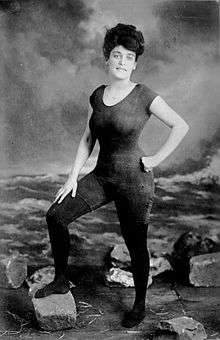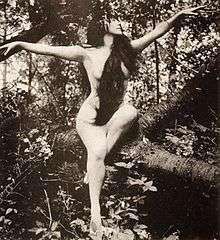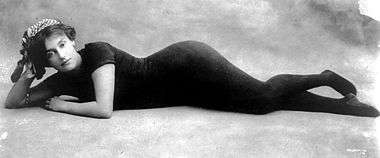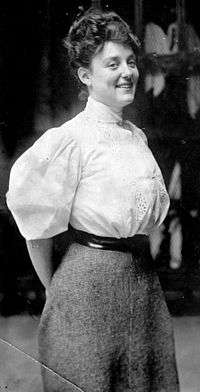Annette Kellermann
| Annette Kellermann | |
|---|---|
 Kellermann in her famous one-piece bathing suit | |
| Born |
Annette Marie Sarah Kellermann 6 July 1887[1] Marrickville, New South Wales, Australia |
| Died |
6 November 1975 (aged 88) Southport, Queensland, Australia |
| Resting place | Great Barrier Reef |
| Nationality | Australian |
| Other names | Annette Marie Sarah Kellermann |
| Education | Mentone Girls' Grammar School |
| Occupation | Swimmer, actress, writer |
| Known for | Swimmer, actress, writer, Inventor of Synchronised Swimming, Pioneer of women's swimwear |
| Religion | Roman Catholic |
| Spouse(s) | James Raymond Louis Sullivan (m. 1912–75) |
Annette Marie Sarah Kellermann (6 July 1887 – 6 November 1975)[1] was an Australian professional swimmer, vaudeville star, film actress, writer, and business owner.
Kellermann was one of the first women to wear a one-piece bathing costume, instead of the then-accepted pantaloons, and inspired others to follow her example. Kellerman's swimming costumes became so popular, that she started her own fashion line of one-piece bathing suits. Kellermann helped popularize the sport of synchronised swimming; and authored a swimming manual. She appeared in several movies, usually with aquatic themes, and as the star of A Daughter of the Gods was the first major actress to appear nude in a Hollywood production. Kellermann was an advocate of health, fitness, and natural beauty throughout her life.
Early life
Kellermann (sometimes recorded as "Kellerman") was born in Marrickville, New South Wales, Australia, on 6 July 1887,[1] to Australian-born violinist Frederick William Kellermann, and his French wife, Alice Ellen Charbonnet, a pianist and music teacher.[2]
At the age of six, a weakness in Kellerman's legs necessitated the wearing of steel braces to strengthen them. To further overcome her disability, her parents enrolled her in swimming classes at Cavill's baths in Sydney. By the age of 13, her legs were practically normal, and by 15, she had mastered all the swimming strokes and won her first race. At this time she was also giving diving displays.[2]
Swimming career

In 1902, Kellermann won the ladies' 100 yards and mile championships of New South Wales in the record times of 1 minute, 22 seconds and 33 minutes, 49 seconds respectively. In that same year, her parents decided to move to Melbourne, Victoria, and she was enrolled at Mentone Girls' Grammar School, where her mother had accepted a music teaching position.[2]
During her time at school, Kellermann gave exhibitions of swimming and diving at the main Melbourne baths, performed a mermaid act at Princes Court entertainment centre, and did two shows a day swimming with fish in a glass tank at the Exhibition Aquarium. In June and July 1903, she performed sensational high dives in the Coogee scene of Bland Holt's spectacular, The Breaking of the Drought, at the Melbourne Theatre Royal.[2]
Kellermann and Beatrice Kerr, who was billed as "Australia's Champion Lady Swimmer and Diver", were rivals, although Kerr's public challenges to Kellermann to meet in a competitive race went unanswered.[3]
On 24 August 1905, aged 19, Kellermann was one of the first women to attempt to swim the English Channel. After three unsuccessful swims she declared, "I had the endurance but not the brute strength." The first woman to attempt a Channel crossing had been Austrian Baroness Walburga von Isacescu, in September 1900.[4] Kellermann later challenged and defeated Isacescu in a Danube race.[5]
Kellermann helped popularize the sport of synchronised swimming after her 1907 performance of the first water ballet in a glass tank at the New York Hippodrome.
Swimwear line
Kellermann was famous for advocating the right of women to wear a one-piece bathing suit, which was controversial at the time.[6] According to an Australian magazine, "In the early 1900s, women were expected to wear cumbersome dress and pantaloon combinations when swimming. In 1907, at the height of her popularity, Kellermann was arrested on Revere Beach, Massachusetts, for indecency – she was wearing one of her fitted one-piece costumes."[7]
The popularity of her one-piece suits resulted in her own line of women's swimwear. The "Annette Kellermans", as they were known, were the first step to modern swimwear.
Film career

In 1916, Kellermann became the first major actress to do a nude scene when she appeared fully nude in A Daughter of the Gods.[8] Made by Fox Film Corporation, A Daughter of the Gods was the first million-dollar film production. Like many of Kellerman's other films, this is now considered a lost film as no copies are known to exist.
The majority of Kellermann's films had themes of aquatic adventure. She performed her own stunts including diving from ninety-two feet into the sea and sixty feet into a pool of crocodiles. Many times she would play mermaids named Annette or variations of her own name. Her "fairy tale films", as she called them, started with The Mermaid (1911), in which she was the first actress to wear a swimmable mermaid costume on film, paving the way for future screen sirens such as Glynis Johns (Miranda), Esther Williams and Daryl Hannah (Splash). Kellermann designed her own mermaid swimming costumes and sometimes made them herself. Similar designs are still used by The Weeki Wachee Springs Mermaids, including her aquatic fairy costume first introduced in Queen of the Sea (1918).
Kellermann appeared in one of the last films made in Prizma Color, Venus of the South Seas (1924), a US/New Zealand co-production where one reel of the 55-minute film was in colour and underwater. Venus of the South Seas was restored by the Library of Congress in 2004 and is the only feature film starring Kellermann known to exist in its complete form.
Publications
In addition to her film and stage career, Kellermann wrote several books including How to Swim (1918), Physical Beauty: How to Keep It (1919), a book of children's stories titled Fairy Tales of the South Seas (1926), and My Story, an unpublished autobiography. She also wrote numerous mail order booklets on health, beauty, and fitness.
Personal life
Kellermann married her American-born manager, James Sullivan, on or around 26 November 1912 at Danbury, Connecticut.[2]
A lifelong vegetarian, Kellermann owned a health food store in Long Beach, California, later in life. She remained active well into old age, continuing to swim and exercise until a short time before her death. She and her husband returned to live in Australia in 1970, and in 1974 she was honoured by the International Swimming Hall of Fame at Fort Lauderdale, Florida.[2]
Kellerman outlived her husband and died in the hospital at Southport, Queensland, Australia, on 6 November 1975, aged 89. She was cremated with Roman Catholic rites. Her remains were scattered in the Great Barrier Reef. She had no children.[2]

Legacy
In 1908, after a study of 3000 women, Dr Dudley A. Sargent of Harvard University dubbed her the "Perfect Woman" because of the similarity of her physical attributes to the Venus de Milo.[9]
Kellermann's large collection of costumes and theatrical memorabilia was bequeathed to the Sydney Opera House.[2] Today, many of her original costumes and personal items are held by the Powerhouse Museum in Sydney, Australia.
She was portrayed by Esther Williams in the film Million Dollar Mermaid (1952), and Kellerman's name is on a star on the Hollywood Walk of Fame, on Hollywood Boulevard. An award-winning Australian documentary called The Original Mermaid, which was about Kellerman, was produced in 2002.
A brand new swimming complex in Marrickville opened December 2010 was named after her.
The streets in the suburb of Holt in the Australian capital Canberra are all named after notable Australian sportspeople, and Kellermann Close was named for Annette Kellermann.
Filmography

- The Bride of Lammermoor: A Tragedy of Bonnie Scotland (1909)
- Jephtah's Daughter: A Biblical Tragedy (1909)
- The Gift of Youth (1909)
- Entombed Alive (1909)
- Siren of the Sea (1911)
- The Mermaid (1911)
- Neptune's Daughter (1914)
- A Daughter of the Gods (1916)
- National Red Cross Pageant (1917)
- Queen of the Sea (1918)
- What Women Love (1920)
- Venus of the South Seas (1924)
As herself
- Miss Kellerman's Diving Feats (1907)
- Miss Annette Kellerman (1909)
- The Perfectly Formed Woman (1910)
- The Universal Boy (1914/I)
- The Art of Diving (1920)
- Annette Kellermann Performing Water Ballet (1925)
- Annette Kellermann Returns to Australia (1933)
- Water Ballet: Sydney (1940)
- Water Ballet (1941)
Archival footage
- The Love Goddesses (1965)
- The Original Mermaid (2002)
References
- 1 2 3 Wells, Kathryn (17 November 2013). "Annette Kellerman – the modern swimmer for modern women". australia.gov.au. Government of Australia. Retrieved 20 February 2016.
- 1 2 3 4 5 6 7 8 Walsh, G. P (1983). "Kellermann, Annette Marie Sarah (1886–1975)". Australian Dictionary of Biography. Melbourne University Press. Retrieved 15 June 2007.
- ↑ Nelson, Judy (2005). "Australian Dictionary of Biography, Supplementary Volume; Kerr, Beatrice Maude (1887–1971)". Retrieved 22 October 2012.
- ↑ Bohn, Michael (2009). Heroes & Ballyhoo: How the Golden Age of the 1920s Transformed American Sports. Potomac Books Inc.
- ↑ "Great Swim in the Danube". The Week (Friday 22 June 1906).
- ↑ Reader's Digest Services, "Record-breaking swimmers", Australia's Yesterdays: a Look at Our Recent Past, 2nd edition, 1974 p.193
- ↑ "Herstory: Annette Kellerman". The Dawn (54). March 2004. Archived from the original on 18 November 2005. Retrieved 27 September 2010.
- ↑ Robertson, James Crighton (1993). The Hidden Cinema: British Film Censorship in Action, 1913–1975. Routledge. pp. 9–10. ISBN 0-415-09034-2.
- ↑ Modern Woman Getting Nearer The Perfect Figure – Dr. Dudley Sargent of...; 4 December 1910; Text: subject of an article on health refers to Kellermann's body as "...the most ideal figure"; "Sunday Magazine"; accessed November 2015
External links
| Wikimedia Commons has media related to Annette Kellerman. |
| Wikiquote has quotations related to: Annette Kellerman |
- Annette Kellermann at Women Film Pioneers Project
- Annette Kellermann Costume Collection at the Powerhouse Museum
- Article & Photo used in crucial trial on decency between Esquire and the Postmaster General
- Annette Kellermann at the Internet Movie Database